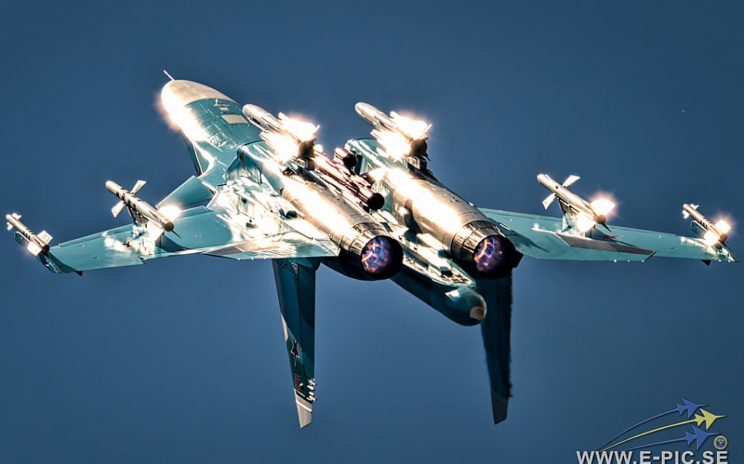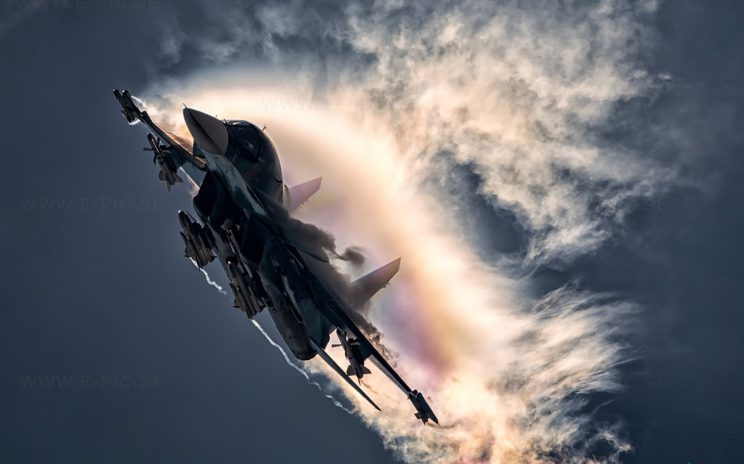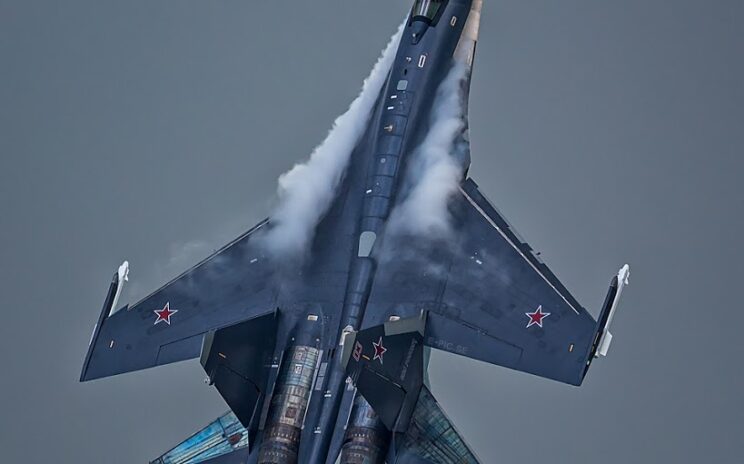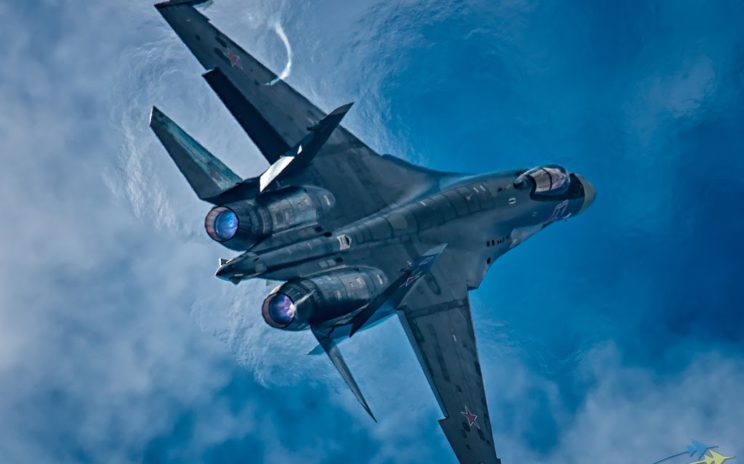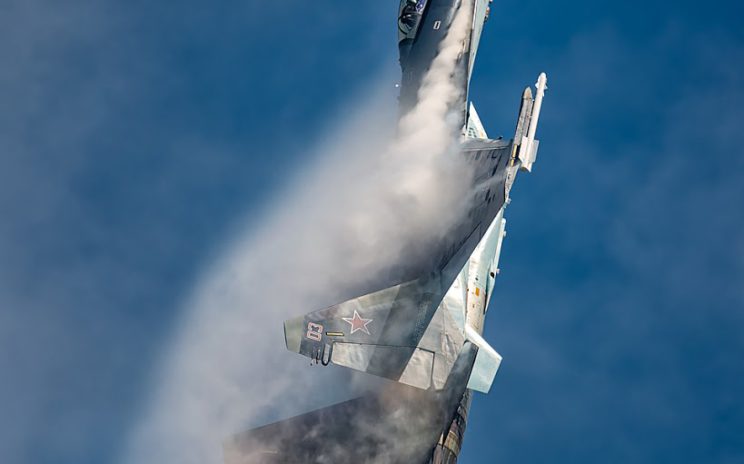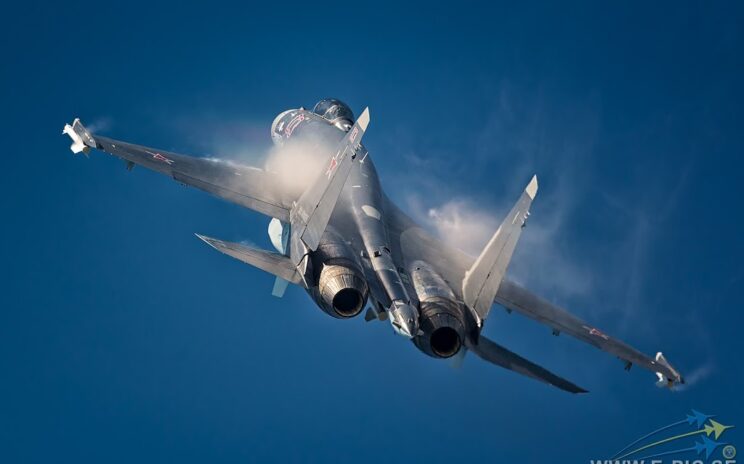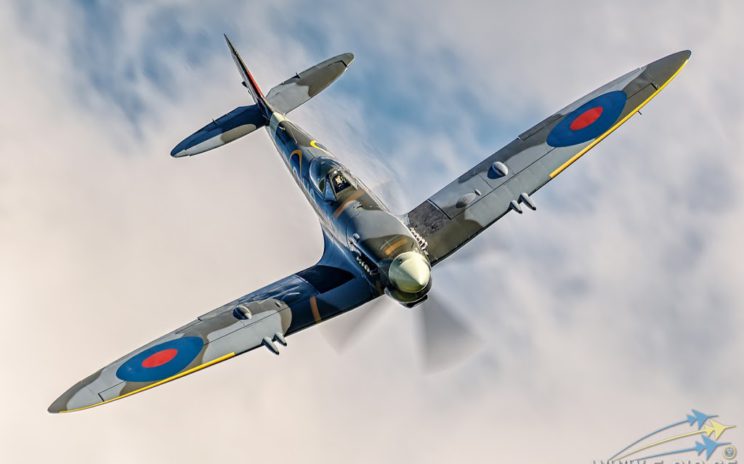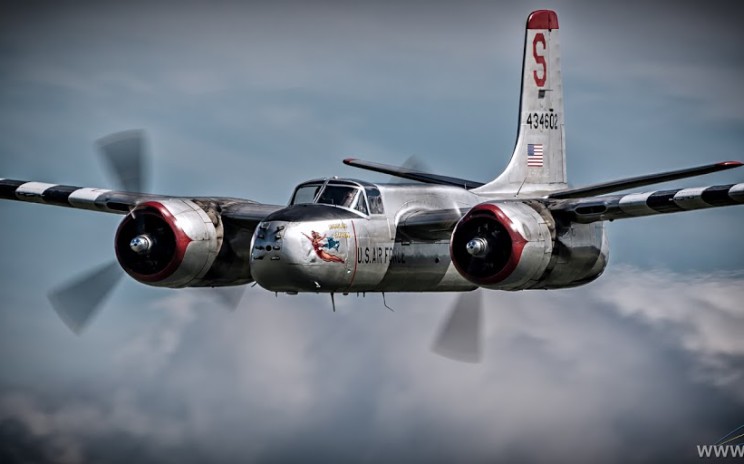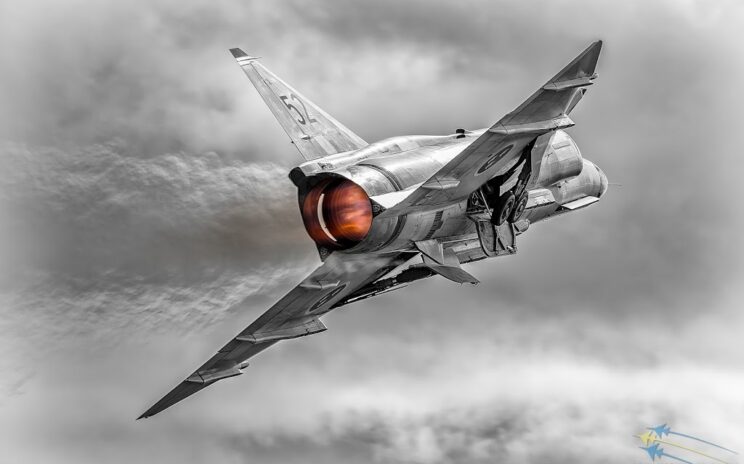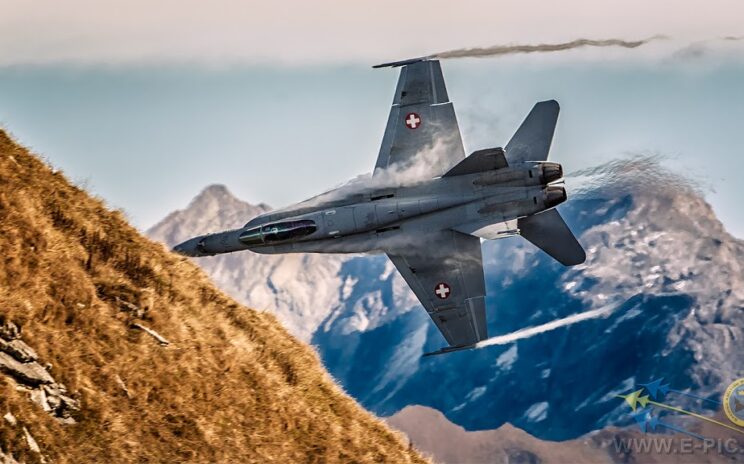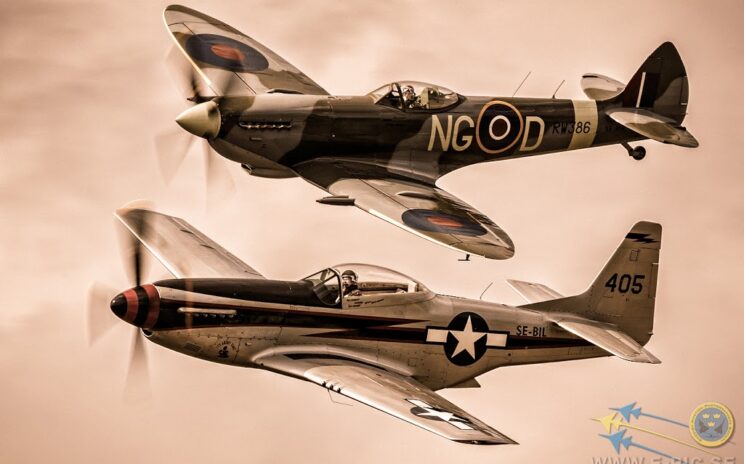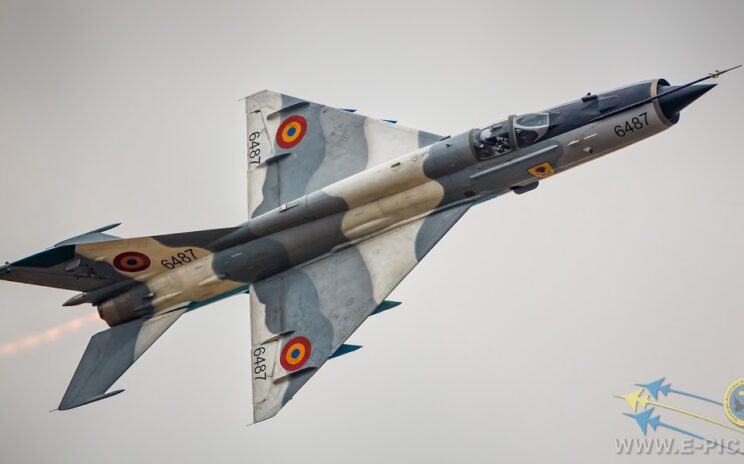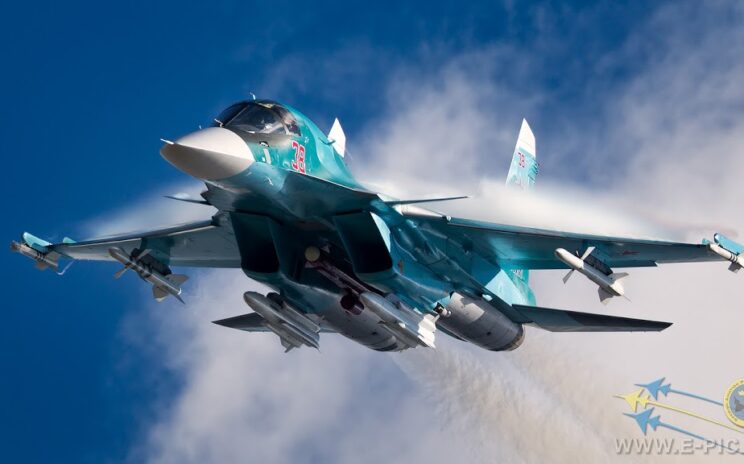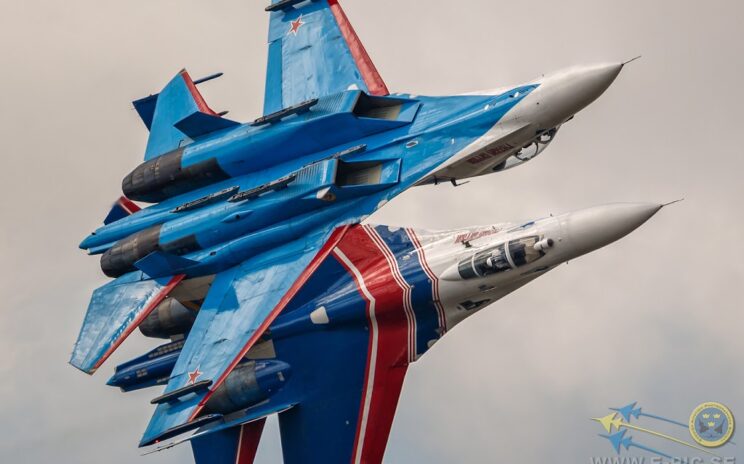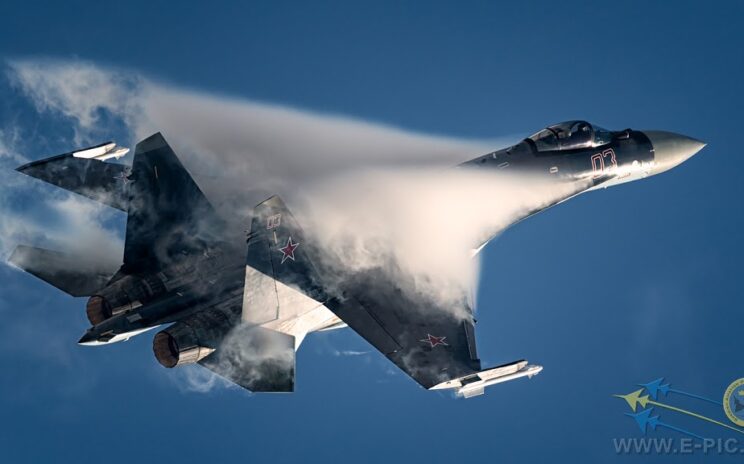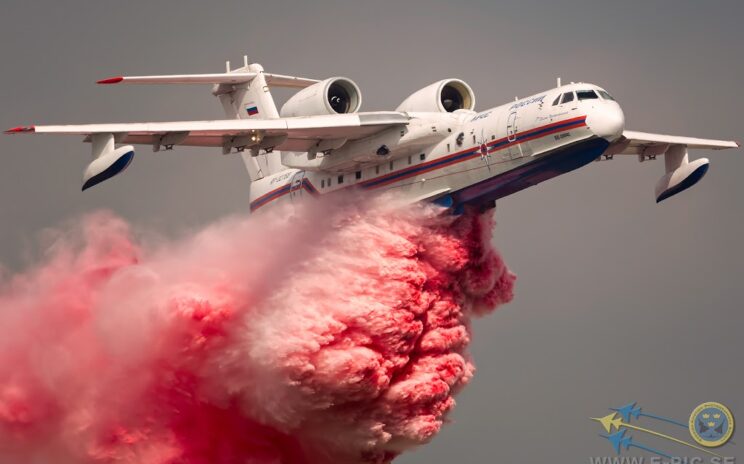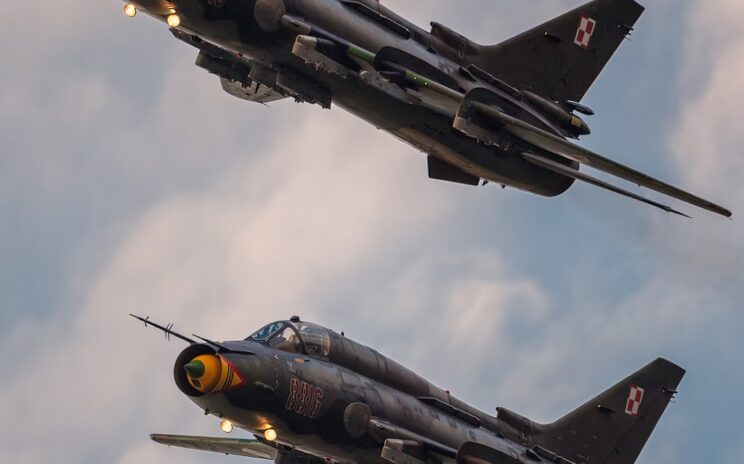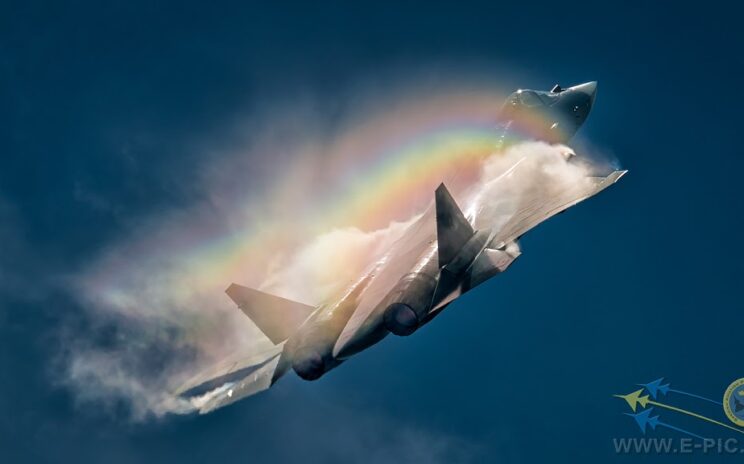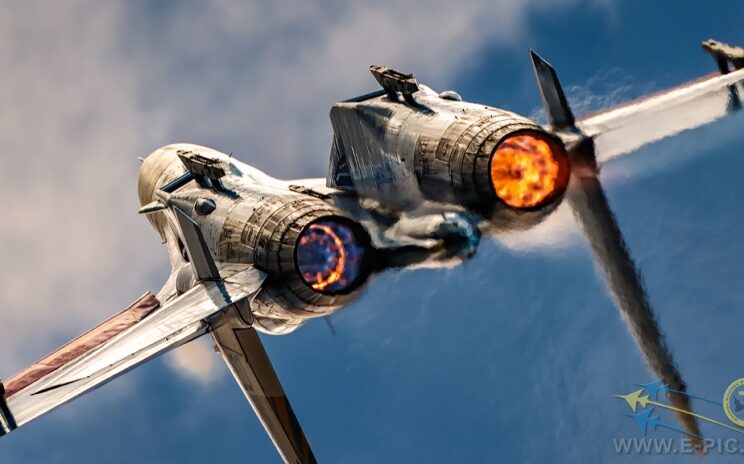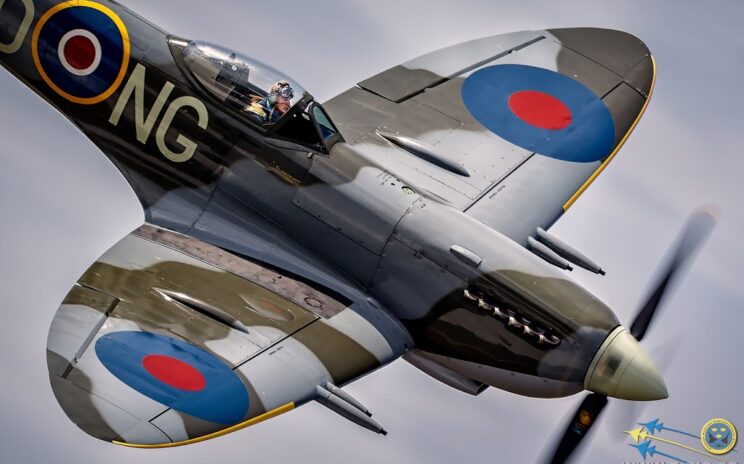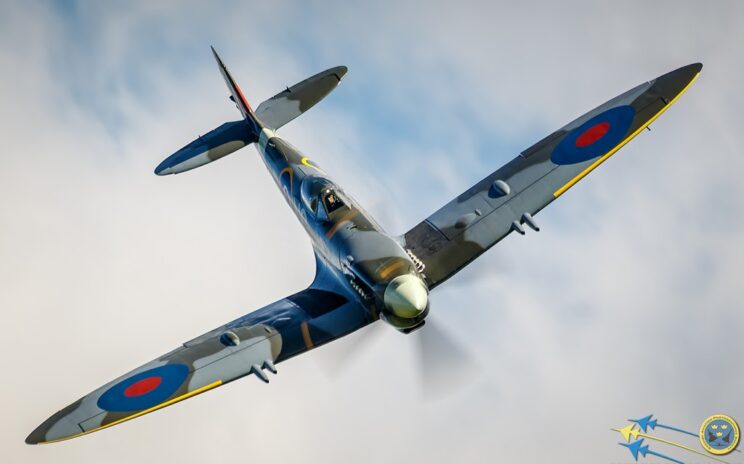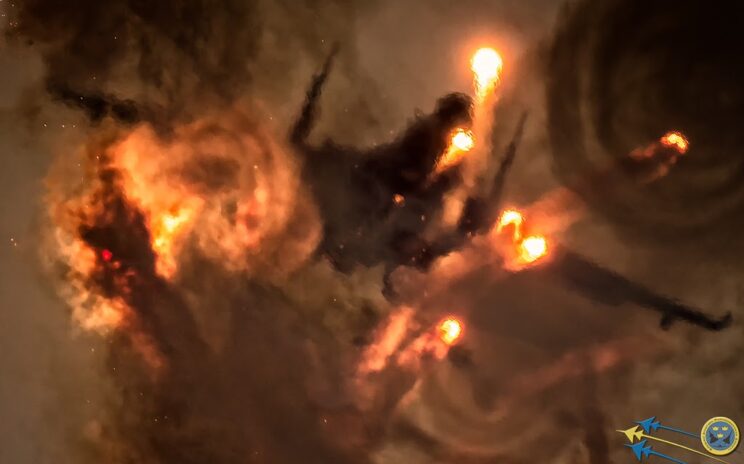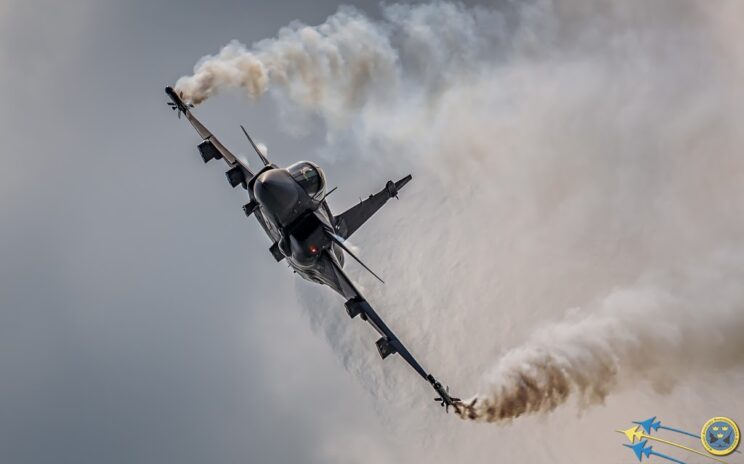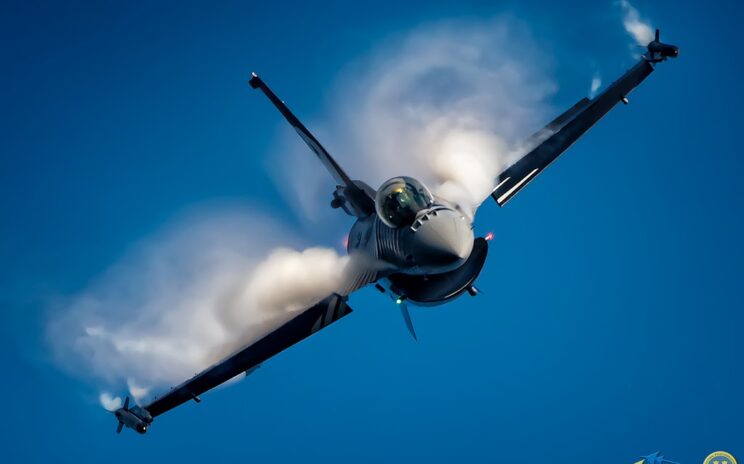Originally shared by +E-pic.se NATO reporting name FullbackSu-34 Theme week Sunday II. http://www.e-pic.se/Aircraft/Aircraft-sorted-by-type/Sukhoi/SU-34-Fullback/ The Sukhoi Su-34 (Russian: Сухой Су-34) (NATO reporting name: Fullback) is a Russian twin-engined, twin-seat strike fighter. It is intended to replace the Sukhoi Su-24. Based on Sukhoi Su-27 'Flanker', the two-seat Su-34 is designed primarily for tactical deployment against ground and naval targets (Tactical bombing/attack/interdiction roles, including against small and mobile targets) on solo and group missions in daytime and at night, under favourable and adverse weather conditions and in a hostile environment with counter-fire and EW counter-measures deployed, as well as for aerial reconnaissance. #Sukhoi #Fullback #Aircraft #Attack #Bomber #Aviation #Jet #E_PIC_SE
Originally shared by +E-pic.se NATO reporting name FullbackSu-34 Theme week Sunday II. http://www.e-pic.se/Aircraft/Aircraft-sorted-by-type/Sukhoi/SU-34-Fullback/ The Sukhoi Su-34 (Russian: Сухой Су-34) (NATO reporting name: Fullback) is a Russian twin-engined, twin-seat strike fighter. It is intended to replace the Sukhoi Su-24. Based on Sukhoi Su-27 'Flanker', the two-seat Su-34 is designed primarily for tactical deployment against ground and naval targets (Tactical bombing/attack/interdiction roles, including against small and mobile targets) on solo and group missions in daytime and at night, under favourable and adverse weather conditions and in a hostile environment with counter-fire and EW counter-measures deployed, as well as for aerial reconnaissance. #Sukhoi #Fullback #Aircraft #Attack #Bomber #Aviation #Jet #E_PIC_SE
Originally shared by +E-pic.se NATO reporting name FullbackSu-34 Theme week Saturday. http://www.e-pic.se/Aircraft/Aircraft-sorted-by-type/Sukhoi/SU-34-Fullback/ The Sukhoi Su-34 (Russian: Сухой Су-34) (NATO reporting name: Fullback) is a Russian twin-engined, twin-seat strike fighter. It is intended to replace the Sukhoi Su-24. Based on Sukhoi Su-27 'Flanker', the two-seat Su-34 is designed primarily for tactical deployment against ground and naval targets (Tactical bombing/attack/interdiction roles, including against small and mobile targets) on solo and group missions in daytime and at night, under favourable and adverse weather conditions and in a hostile environment with counter-fire and EW counter-measures deployed, as well as for aerial reconnaissance. #Sukhoi #Fullback #Aircraft #Attack #Bomber #Aviation #Jet #E_PIC_SE
Originally shared by +E-pic.se Enjoy.BUT there is even more images of this beast here: http://www.e-pic.se/Aircraft/Aircraft-sorted-by-type/Sukhoi/Sukhoi-Su-35S-Flanker-E/ #Sukhoi #Flanker #Su35 #E_PIC_SE #Aircraft #Aviation #Fighter In Album Sukhoi Su-35S Super Flanker
Originally shared by +E-pic.se http://www.e-pic.se/Aircraft/Aircraft-sorted-by-type/Sukhoi/Sukhoi-Su-35S-Flanker-E/ The Sukhoi Su-35 (Russian: Сухой Су-35; NATO reporting name: Flanker-E]) is a heavily upgraded derivative of the Su-27 'Flanker.While the aircraft maintains a strong superficial resemblance to the Su-27, the airframe, avionics, propulsion and weapons systems of the Su-35 have been thoroughly overhauled. Technological advancements have produced more compact and lighter hardware, such as the radar, shifting the centre of gravity to the aircraft's rear. These improvements removed the need for canards (Su-30) and saw the abandonment of the "tandem triplane" featured on several Su-27 derivatives. Also omitted was the Su-27's dorsal airbrake, which was replaced by differential deflection of the vertical stabilizers. Other aerodynamic refinements include a height reduction of the vertical stabilizers, a smaller aft-cockpit hump, and shorter rearward-projecting "sting".The thrust vectoring nozzles operate in one plane for pitch, but the canting allows the aircraft to produce both roll and yaw by vectoring each engine nozzle differently. A similar thrust vectoring system is also implemented on the PAK FA.The engine gives the Su-35 limited supercruise capability, or sustained supersonic speed without the use of afterburners. Radar-absorbent material is applied to the engine inlets and the front stages of the engine compressor to halve […]
Originally shared by +E-pic.se http://www.e-pic.se/Aircraft/Aircraft-sorted-by-type/Sukhoi/Sukhoi-Su-35S-Flanker-E/ The Sukhoi Su-35 (Russian: Сухой Су-35; NATO reporting name: Flanker-E]) is a heavily upgraded derivative of the Su-27 'Flanker.While the aircraft maintains a strong superficial resemblance to the Su-27, the airframe, avionics, propulsion and weapons systems of the Su-35 have been thoroughly overhauled. Technological advancements have produced more compact and lighter hardware, such as the radar, shifting the centre of gravity to the aircraft's rear. These improvements removed the need for canards (Su-30) and saw the abandonment of the "tandem triplane" featured on several Su-27 derivatives. Also omitted was the Su-27's dorsal airbrake, which was replaced by differential deflection of the vertical stabilizers. Other aerodynamic refinements include a height reduction of the vertical stabilizers, a smaller aft-cockpit hump, and shorter rearward-projecting "sting".The thrust vectoring nozzles operate in one plane for pitch, but the canting allows the aircraft to produce both roll and yaw by vectoring each engine nozzle differently. A similar thrust vectoring system is also implemented on the PAK FA.The engine gives the Su-35 limited supercruise capability, or sustained supersonic speed without the use of afterburners. Radar-absorbent material is applied to the engine inlets and the front stages of the engine compressor to halve […]
Originally shared by +E-pic.se MAKS 2015 http://www.e-pic.se/Aircraft/Aircraft-sorted-by-type/Sukhoi/Sukhoi-Su-35S-Flanker-E/ The Sukhoi Su-35 (Russian: Сухой Су-35; NATO reporting name: Flanker-E]) is a heavily upgraded derivative of the Su-27 'Flanker.While the aircraft maintains a strong superficial resemblance to the Su-27, the airframe, avionics, propulsion and weapons systems of the Su-35 have been thoroughly overhauled. Technological advancements have produced more compact and lighter hardware, such as the radar, shifting the centre of gravity to the aircraft's rear. These improvements removed the need for canards (Su-30) and saw the abandonment of the "tandem triplane" featured on several Su-27 derivatives. Also omitted was the Su-27's dorsal airbrake, which was replaced by differential deflection of the vertical stabilizers. Other aerodynamic refinements include a height reduction of the vertical stabilizers, a smaller aft-cockpit hump, and shorter rearward-projecting "sting".The thrust vectoring nozzles operate in one plane for pitch, but the canting allows the aircraft to produce both roll and yaw by vectoring each engine nozzle differently. A similar thrust vectoring system is also implemented on the PAK FA.The engine gives the Su-35 limited supercruise capability, or sustained supersonic speed without the use of afterburners. Radar-absorbent material is applied to the engine inlets and the front stages of the engine compressor […]
Originally shared by +E-pic.se Supermarine 361 Spitfire LF16EBiltemas Spitfire shot at Flygfesten 2015 in Dala-Järna. More Spitfire images here: http://www.e-pic.se/Aircraft/Aircraft-sorted-by-type/Supermarine/Supermarine-Spitfire/ #Supermarine #Spitfire #Aircraft #Aviation #Fighter #E_PIC_SE
Originally shared by +E-pic.se Dala-Järna 2015 http://www.e-pic.se/Aircraft/Aircraft-sorted-by-type/Douglas/Douglas-A-26B-Invader/ The Douglas A-26 Invader (designated B-26 between 1948 and 1965) is a twin-engined light bomber and attack aircraft that was built by Douglas Aircraft Company during World War II which also saw service during several major Cold War conflicts. It was found to be a fast aircraft capable of carrying twice its specified bomb load. A range of guns could be fitted to produce a formidable ground-attack aircraft.The A-26 was originally built in two different configurations. The A-26B had a gun nose, which originally could be equipped with a combination of armament including .50 caliber machine guns, 20mm or 37mm auto cannon, or even a 75mm pack howitzer. Normally the gun nose version housed six (or later eight) .50 caliber machine guns, officially termed the "all-purpose nose", later commonly known as the "six-gun nose" or "eight-gun nose". The A-26C 's "glass" nose, officially termed the "Bombardier nose", contained a Norden bombsight for medium altitude precision bombing. The A-26C nose section included two fixed M-2 guns, later replaced by underwing gun packs or internal guns in the wings.After about 1,570 production aircraft, three guns were installed in each wing, coinciding with the introduction of […]
Originally shared by +E-pic.se More images of the mighty Viggen can be found here: http://www.e-pic.se/Aircraft/Aircraft-sorted-by-type/SAAB/SAAB-AJS-37-Viggen/ #Saab #Viggen #Aircraft #Aviation #E_PIC_SE #Photo #Saabinthesky In Album Saab AJS 37 Viggen
Originally shared by +E-pic.se http://www.e-pic.se/Aircraft/Aircraft-sorted-by-type/McDonnel-Douglas/McDonnell-Douglas-F-18-Hornet/ The McDonnell Douglas (now Boeing) F/A-18 Hornet is a twin-engine supersonic, all-weather carrier-capable multirole combat jet, designed as both a fighter and attack aircraft (F/A designation for Fighter/Attack). Designed by McDonnell Douglas and Northrop, the F/A-18 was derived from the latter's YF-17 in the 1970s for use by the United States Navy and Marine Corps. The Hornet is also used by the air forces of several other nations. The U.S. Navy's Flight Demonstration Squadron, the Blue Angels, has used the Hornet since 1986.The U.S. Navy started the Naval Fighter-Attack, Experimental (VFAX) program to procure a multirole aircraft to replace the Douglas A-4 Skyhawk, the A-7 Corsair II, and the remaining McDonnell Douglas F-4 Phantom IIs, and to complement the F-14 Tomcat.Though the YF-16 won the LWF competition, the Navy was skeptical that an aircraft with one engine and narrow landing gear could be easily or economically adapted to carrier service, and refused to adopt an F-16 derivative. On 2 May 1975 the Navy announced its selection of the YF-17. Since the LWF did not share the design requirements of the VFAX, the Navy asked McDonnell Douglas and Northrop to develop a new aircraft from the […]
Originally shared by +E-pic.se Cavalier F-51D Mustang 2 & Supermarine 361 Spitfire LF16E.This is probably the two most iconic aircraft of WWII. More Mustang images here: http://www.e-pic.se/Aircraft/Aircraft-sorted-by-type/North-American/North-American-P-51D-Mustang More Spitfire images here: http://www.e-pic.se/Aircraft/Aircraft-sorted-by-type/Supermarine/Supermarine-Spitfire #Supermarine #Spitfire #Mustang #Aircraft #Aviation #Warbirds #E_PIC_SE #Biltema
Originally shared by +E-pic.se Radom 2015 http://www.e-pic.se/Aircraft/Aircraft-sorted-by-type/Mikoyan-Gurevich/MiG-21-Lancer/ The Mikoyan-Gurevich MiG-21 (Russian: Микоян и Гуревич МиГ-21; NATO reporting name: Fishbed) is a supersonic jet fighter aircraft, designed by the Mikoyan-Gurevich Design Bureau in the Soviet Union. It was popularly nicknamed "Balalaika", from the aircraft's planform-view resemblance to the Russian stringed musical instrument or ołówek (English: pencil) by Polish pilots due to the shape of its fuselage.A total of 10,645 aircraft were built in the USSR, 194 MiG-21F-13s were built under licence in Czechoslovakia and India built 657 MiG-21FL, MiG-21M and MiG-21bis.Like many aircraft designed as interceptors, the MiG-21 had a short range. This was not helped by the poor placement of the fuel tanks, which caused the airplane's center of gravity to shift rearwards once two-thirds of the fuel had been used. This had the effect of making the plane statically unstable to the point of being uncontrollable, resulting in an endurance of only 45 minutes in clean condition. Additionally when more than half the fuel was used up in early versions, violent maneuvers prevented fuel from flowing into the engine, thereby causing it to shut down mid flight. Source: Wikipedia #Mig #Lancer #Fishbed #Aircraft #Aviation #Fighter #E_PIC_SE
Originally shared by +E-pic.se MAKS 2015http://www.e-pic.se/Aircraft/Aircraft-sorted-by-type/Sukhoi/SU-34-Fullback/ The Sukhoi Su-34 (Russian: Сухой Су-34) (NATO reporting name: Fullback) is a Russian twin-engined, twin-seat strike fighter. It is intended to replace the Sukhoi Su-24. Based on Sukhoi Su-27 'Flanker', the two-seat Su-34 is designed primarily for tactical deployment against ground and naval targets (Tactical bombing/attack/interdiction roles, including against small and mobile targets) on solo and group missions in daytime and at night, under favourable and adverse weather conditions and in a hostile environment with counter-fire and EW counter-measures deployed, as well as for aerial reconnaissance. The aircraft shares most of its wing structure, tail, and engine nacelles with the Su-27/Su-30, with canards like the Su-30MKI, Su-33, and Su-27M/35 to increase static instability (higher manoeuvrability) and to reduce trim drag. The aircraft has an entirely new nose and forward fuselage with a cockpit providing side-by-side seating for a crew of two. The Su-34 is powered by a pair of Saturn AL-31FM1 turbofan engines, the same engines used on the Su-27SM; giving the aircraft a maximum speed of Mach 1.8+ when fully loaded. When equipped with a full weapons load, the Su-34 has a maximum range of 4,000 kilometres (2,500 mi) without refuelling, this can […]
Originally shared by +E-pic.se Goose: Communicating… Maverick: Communicating, keeping up foreign relations.Goose: [Extending his middle finger] You know, the finger! Charlie: Yes, I know the finger, Goose. The Russian Knights, Sukhoi Su-27 Flanker http://www.e-pic.se/Aircraft/Aircraft-sorted-by-type/Sukhoi/Sukhoi-Su-27-Flanker-Russian-Kni#!/ #Sukhoi #Flanker #Aircraft #Aviation #Fihgter #jet #E_PIC_SE
Originally shared by +E-pic.se MAKS 2015 http://www.e-pic.se/Aircraft/Aircraft-sorted-by-type/Sukhoi/Sukhoi-Su-35S-Flanker-E/ The Sukhoi Su-35 (Russian: Сухой Су-35; NATO reporting name: Flanker-E]) is a heavily upgraded derivative of the Su-27 'Flanker.While the aircraft maintains a strong superficial resemblance to the Su-27, the airframe, avionics, propulsion and weapons systems of the Su-35 have been thoroughly overhauled. Technological advancements have produced more compact and lighter hardware, such as the radar, shifting the centre of gravity to the aircraft's rear. These improvements removed the need for canards (Su-30) and saw the abandonment of the "tandem triplane" featured on several Su-27 derivatives. Also omitted was the Su-27's dorsal airbrake, which was replaced by differential deflection of the vertical stabilizers. Other aerodynamic refinements include a height reduction of the vertical stabilizers, a smaller aft-cockpit hump, and shorter rearward-projecting "sting".The thrust vectoring nozzles operate in one plane for pitch, but the canting allows the aircraft to produce both roll and yaw by vectoring each engine nozzle differently. A similar thrust vectoring system is also implemented on the PAK FA.The engine gives the Su-35 limited supercruise capability, or sustained supersonic speed without the use of afterburners. Radar-absorbent material is applied to the engine inlets and the front stages of the engine compressor […]
Originally shared by +E-pic.se MAKS 2015 http://www.e-pic.se/Aircraft/Aircraft-sorted-by-type/Beriev/Beriev-Be-200-Altair/ The multirole Be-200 can be configured as an amphibious water drop fire-fighting aircraft, a freighter, or as a passenger aircraft—the pressurised and air conditioned cabin allowing transportation of up to 72 passengers. The Be-200 can also be equipped for special missions. When configured as an air ambulance, the aircraft can carry up to 30 stretcher patients and seven seated patients or medical crew. In the search and rescue role, the aircraft can be equipped with searchlights and sensors, an inflatable boat, thermal and optical surveillance systems, and medical equipment. The search and rescue variant can accommodate up to 45 persons. The aircraft is also capable of being configured for anti-submarine warfare duties.[1][13] The Be-200 fire-fighter suppresses fires by dropping water and/or chemical retardants. Eight ferric aluminium alloy water tanks are located under the cabin floor in the centre fuselage section. Four retractable water scoops, two forward and two aft of the fuselage step can be used to scoop a total of 12 tonnes of water in 14 seconds. Alternatively, the tanks can be filled from a hydrant or a water cistern on the ground. The water tanks can be removed quickly for carrying […]
Originally shared by +E-pic.se http://www.e-pic.se/Aircraft/Aircraft-sorted-by-type/Sukhoi/Sukhoi-Su-22M4/ The Sukhoi Su-17 / Su-22 (NATO reporting name: Fitter) is a Soviet variable-sweep wing fighter-bomber developed from the Sukhoi Su-7. It enjoyed a long career in Soviet, later Russian, service and was widely exported to Eastern Bloc, Middle Eastern air forces and Latin America as the Su-20 and Su-22. Seeking to improve low-speed and take-off/landing performance of the Su-7B fighter-bomber, in 1963 the Sukhoi OKB with input from TsAGI created a variable-sweep wing technology demonstrator. . A fixed inner wing simplified construction, allowing the manufacturer to retain the Su-7 landing gear and avoiding the need for complex pivoting underwing hardpoints, and it minimized the shift in the center of pressure relative to the center of mass with change in wing sweep. The new wing also had extensive leading-edge slats and trailing-edge flaps.The production aircraft was named Su-17 (NATO designation "Fitter-C") and was unofficially dubbed Strizh (Стриж, martlet) in service. Aside from the new wing, it differed from its predecessor Su-7 in having a new canopy and a dorsal fuselage spine for additional fuel and avionics. The Su-17 first flew on 1 July 1969 with E. K. Kukushev at the controls. A total of 2,867 Su-17 […]
Originally shared by +E-pic.se MAKS 2015http://www.e-pic.se/Aircraft/Aircraft-sorted-by-type/Sukhoi/Sukhoi-PAK-FA-T-50/ The T-50's design emphasizes frontal stealth, with RCS-reducing features most apparent in the forward hemisphere; the shaping of the aft fuselage is much less optimized for radar stealth compared to the F-22.[74] The combined effect of airframe shape and RAM of the production aircraft is estimated to have reduced the aircraft's RCS to a value thirty times smaller than that of the Su-27.[80] Sukhoi's patent of the T-50's stealth features cites an average RCS of the aircraft of approximately 0.1-1 square meters.[79] However, like other stealth fighters, the T-50's low observability measures are chiefly effective against high frequency (between 3 and 30 GHz) radars, usually found on other aircraft. The effects of Rayleigh scattering and resonance mean that low-frequency radars, employed by weather radars and early-warning radars are more likely to detect the T-50 due to its physical size. However, such radars are also large, susceptible to clutter, and are less precise. #Aviation #Aircraft #Sukhoi #PAKFA #Fighter #E_PIC_SE
Originally shared by +E-pic.se The Russian Knights, Su-27 Flanker. http://www.e-pic.se/Aircraft/Aircraft-sorted-by-type/Sukhoi/Sukhoi-Su-27-Flanker-Russian-Kni/ #Sukhoi #Flanker #Russian #Knights #Fighter #Aircraft #Aviation #E_PIC_SE
Originally shared by +E-pic.se Biltemas Spitfire shot at Flygkalaset 2015 in Växjö. More Spitfire images here: http://www.e-pic.se/Aircraft/Aircraft-sorted-by-type/Supermarine/Supermarine-Spitfire/ #Supermarine #Spitfire #Aircraft #Aviation #Fighter #E_PIC_SE
Originally shared by +E-pic.se Biltemas Spitfire shot at Flygfesten 2015 in Dala-Järna. More Spitfire images here: http://www.e-pic.se/Aircraft/Aircraft-sorted-by-type/Supermarine/Supermarine-Spitfire/ #Supermarine #Spitfire #Aircraft #Aviation #Fighter #E_PIC_SE In Album 2015 Dala-Järna “Flygfesten”
Now that is a great aviation action shot by +E-pic.se Originally shared by +E-pic.se "Like a bat out of hell!"Sukhoi Su-27 Flanker – Team Russian Knightshttp://www.e-pic.se/Aircraft/Aircraft-sorted-by-type/Sukhoi/Sukhoi-Su-27-Flanker-Russian-Kni/ TIP: When shooting aircraft, dont stop because the weather gets bad!I got this shot when almost everybody had given up because it was raining heavily with a really low cloud base.This Su-27 comes overhead and drops these flares, the rain, humidity and really low light gives this magical light to the shot. smile emoticon #MAKS #Sukhoi #Flanker #Aircraft #Aviation #Fighter #E_PIC_SE
Originally shared by +E-pic.se http://www.e-pic.se/Aircraft/Aircraft-sorted-by-type/SAAB/SAAB-39-Gripen/SAAB-JAS-39-Gripen/Gripen Solo display flown by Peter Fällén. #Saab #Gripen #Fighter #Aircraft #Aviation #E_PIC_SE
Now those are are GREAT Aviation shots!! +E-pic.se 377 followers – that needs to change.. Originally shared by +E-pic.se Solo Türk at Kleine Brogel 2014General Dynamics (TUSAS) F-16CG Night Falcon (401)http://www.e-pic.se/Aircraft/Aircraft-sorted-by-type/General-Dynamics/F16-Fighting-Falcon/The livery's color scheme consists of bright black, silver and golden representing the dance of power and technology with clouds. A graphic design on the bottom of the aircraft depicts the Turkish flag while on the vertical stabilizer a large eagle head is painted.#Fighting #Falcon #Aircraft #Aviation #Fighter #E_PIC_SE In Album 2014 Kleine Brogel
